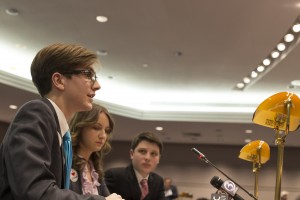[soundcloud id=’193027152′]
By Danielle Chaloux
After a long day of classes, work, research and studying for quickly approaching midterms, over 30 representatives from the University of Connecticut traveled to the state capitol Tuesday night, where they voiced their opposition to over $10 million dollars in proposed budget cuts in higher education. While by far the largest delegation, UConn was not alone in concern for the future of higher education in Connecticut.
“We are the teachers, the police officers, the welders, and the social workers. We are the parents trying to build a better life for our children,” said Sarah Greco, a graduate student at Southern Connecticut State University, and the chair of the Student Advisory Committee to the Board of Regents. “We are the daughters and sons caring for aging parents or siblings with disabilities.”
Greco echoed the same concerns about increased tuition rates, larger class sizes, and less time with faculty that UConn students have. UConn freshman Joy Sgobbo spoke to UConn’s affordability, saying that, “Besides my love of the UConn Huskies, and the campus environment itself, the practical cost of UConn was one of the biggest factors that drew me to attend.”
Even with a tuition increase of 6.5%, UConn still faces a budget deficit of $46 million dollars. The current budget of Governor Dannel Malloy continues a trend of waning state support for UConn. The university has seen a 13% decrease in state aid since 2008, even as the governor pushes initiatives to keep young people in Connecticut. This discrepancy was noted by several of the witnesses who testified, not just from UConn. As Walter Harrison, the president of the University of Hartford said, “Don’t cut the opportunity for Connecticut students to go to Connecticut universities.”
The challenges of this budget come, in part, from the changing demands placed on the public university system. Originally conceived as teacher’s colleges or “land grant” institutions, which focused on agriculture and engineering, public institutions of higher education have diversified. The Connecticut State University system, comprised of Eastern, Central, Southern and Western, offers graduate and undergraduate programs in 160 different subject areas. Here in Storrs, UConn has been ranked 19th overall by the U.S. News and World Report. Looking to the future, Jeremy Teitelbaum, the Dean of UConn’s College of Liberal Arts and Sciences, had this to offer, “We don’t need to graduate people who know things, we desperately need to graduate people who know how to figure out new things.”
Students across the state will be waiting for the final budget to pass, all hoping for their school’s funding to be restored.


